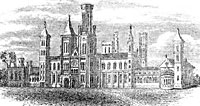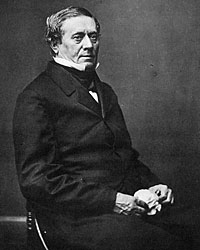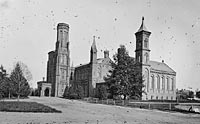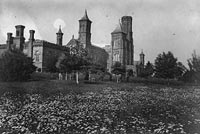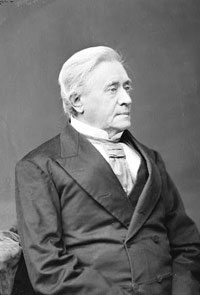By the Civil War, the Smithsonian Institution had truly become an institution. The director was physicist Joseph Henry whom President Lincoln sometimes consulted on scientific questions. President Lincoln occasionally attended lectures at the Smithsonian, which was headquartered on the Capitol Mall in a red stone building built finished six years before the Civil War. These lectures were organized to satisfy the intellectual demands of a Washington swelled with people during the war. According to journalist Ben Perley Poore, “With this importation of Northern brains came a desire to hear lectures from prominent men, and Professor Henry was reluctantly induced to grant the use of the lecture hall of the Smithsonian Institution, with a promise that it should be announced that the Institution was not to be held responsible for what might be said.”1
Ernest B. Furgurson wrote in Freedom Rising: Washington in the Civil War, “As the first director of the Smithsonian Institution, Henry was not enthusiastic about the war, wishing that his scholarly enterprise could somehow stay neutral, above it all (William Howard Russell of the Times of London wrote that Henry ‘treated slavery as a geological question,’ while his assistant director, Spencer Baird, ‘connected it with climate and the Valley of the Mississippi.’) But Henry was a leading physicist who had devised early version of the telegraph and the electric motor, and was ready to promote any technology that might advance the cause of science.”2
Historian Constance McLaughlin Green wrote: “In 1861 he believed the Union doomed and the role of the Smithsonian imperilled. In fact the loss of money invested in southern securities sharply curtailed the endowment funds of the Institution. Desperately anxious to keep it free of ‘inauspicious connextions’ with political entanglements, the secretary, after two or three unhappy experiences with abolitionist lecturers, refused to let any partisan group use the Smithsonian halls. In 1862, however, Henry grimly noted that ‘the art of destroying life, as well as that of preserving it, calls for the application of scientific principles and the institution of experiments on a scale of magnitude which would never be attempted in time of peace. The Smithsonian consequently, while endeavoring to carry on its normal activities, undertook some military research programs…”3
Henry’s patriotism was questioned, according to California journalist Noah Brooks: “One evening, while I was sitting with the President in his cabinet, Professor Henry, then in charge of the Smithsonian, came in for a social chat with the President. The conversation ran upon various unimportant themes, and presently a card was brought in by the doorkeeper, who said that the man in waiting was extremely urgent to see the President, as he had matters of pressing importance to communicate. He was brought into the room, and proved to be a modest shopkeeper whose home was not far from the Smithsonian Institution. Glancing uneasily at the President’s two visitors, whom he evidently did not know, he said his business was very important and should be kept secret. The President assured him that Professor Henry and myself were to be trusted with any business of state, however secret it might be; and he genially encouraged his visitor to speak out without fear of being betrayed in case the weighty matter which he carried in his mind was of an explosive character. The man then went on to say that he had frequently observed lights shown from one of the towers of the Smithsonian Institution late at night. He had noticed that these lights invariably made their appearance about the same time (at midnight), and he was confident that the person displaying them was carrying on a contraband correspondence with the rebels by means of signals. The President, with great gravity, closely examined the witness, but elicited nothing more from him than the fact that the lights were actually shown.”
The President said: “Do you suspect anybody in the Smithsonian Institution?”
With that the President turned to Professor Henry, and, with admirable command of countenance, said, ‘This is Professor Henry; perhaps he will be able to answer for himself.” The look of dismay on the countenance of the visiting witness was so comic that the President could not restrain his laughter. Professor Henry, who was somewhat disturbed by this expression on the part of the well-meaning but mistaken Unionist, very briefly disposed of his tale. He explained that the scientific instruments used to ascertain the direction and force of the wind, temperature, etc., were examined at certain hours of the day and night for the purpose of taking their record, and that the supposed signal-light in the Smithsonian tower was the lantern carried to the observatory at midnight by the attendant who made those observations. Somewhat crestfallen, the visitor withdrew, the President thanking him for his vigilance and well-meant promptness in reporting this incident, and adding, as the man departed, ‘If you should see any indications of a rebel conspiracy in Washington, you will do the country real service by reporting at once to headquarters.”4
Another version of the story reported that President Lincoln “turned a whimsical smile upon a beetle-browed man who sat contemplative in the corner of his room, and said, ‘Now you’re caught. What have you to say, Professor Henry, why sentence of death should not immediately be pronounced upon you?” Concern about Henry’s patriotism extended to Congress. Journalist William A. Croffut organized an anti-slavery lecture series and tried to get Henry to allow use of “the large amphitheatre of the Smithsonian….He was struck with horror at the sacrilegious suggestion and froze me out with harsh words which made me almost wish that I had been burdened with less responsibility. Heavy-hearted, I took all these troubles to the Honorable Owen Lovejoy, with whom I had the privilege of such acquaintance as a zealous young recruit might enjoy with a kind-hearted veteran, and he valiantly entered the lists. ‘Henry’s an old traitor!’ he exclaimed hotly. ‘We’ll bring him to terms. Come with me.’ And he led the way to the rooms of the Honorable Schuyler Colfax. Here, too, was a sympathetic listener. ‘I am a regent of the Smithsonian,’ Mr. Colfax said, ‘and [Vice President Hannibal] Hamlin is another. I’ll see him to-day about it. Call at my residence to-morrow morning at ten o’clock and bring [the Reverend] John Pierpont, and we’ll do something.”5 When Henry protested that the Smithsonian regents would object to such use, Colfax and Hamlin pointed out that many of them had deserted to the Confederacy and the new regents which President Lincoln was proposing would not object.
Croffut recalled: “For a fortnight, while lecturers were being engaged, the siege of the Smithsonian was carried on. Gradually Professor Henry weakened and prepared to surrender. Lincoln took a hand. It was finally agreed that the dreadful innovation should be tried, but he stipulated that it must be published that it was against his remonstrance, and that the presiding officer should make it distinctly understood at every lecture that the Smithsonian Institution was in no way responsible for the sentiments avowed.” Among the eventual speakers for the newly established Washington Lecture Association were Joseph Holt, Frederick Douglass, Wendell Phillips, John Jay, Daniel S. Dickinson, Ralph Waldo Emerson, and Orestes A. Brownson, Dr. Henry insisted on a disclaimer before each lecture, delivered by Dr. John Pierpont, himself a noted poet speaker: “Ladies and Gentlemen: I am requested by Professor Henry to announce that the Smithsonian Institution is not in any way responsible for this course of lectures. I do so with pleasure, and desire to add that the Washington Lecture Association is in no way responsible for the Smithsonian Institution.” The disclaimer became a standing Washington joke which elicited “cheers and laughter” each time it was repeated.6
On January 3, 1863, Mr. Lincoln attended the fifth in the series – this one given by New York Tribune editor Horace Greeley. Horace Greeley specifically asked if President Lincoln would be present for his lecture so Croffut went to the White House to inquire. “Yes, I will,” replied the President. “I can get away can’t I, Hay?” he asked a close aide. “I never heard Greeley, and I want to hear him. In print every one of his words seems to weigh about a ton; I want to see what he has to say about us.” That night, President Lincoln joined three Cabinet members – Edward Bates, Salmon P. Chase, and Gideon Welles – on the platform. “Before introducing the speaker, President Pierpont began, as usual, ‘It is my duty and pleasure to announce to you, ladies and gentlemen, that the Smithsonian Instit—‘ The rest of the reminder, which had become amusingly familiar, was drown in a great roar of laughter. Mr. Lincoln turned, with a puzzled smile, and asked the nearest officer of the Association what it meant. When it was briefly explained as the proclamation required by the Smithsonian at the beginning of each lecture, he joined in the laugh heartily, though a trifle behindhand. The object of it – Professor Henry – was within ten feet, concealed from the audience behind the little door that opened on the platform from the rear. Here, after the first lecture, he was generally found listening to the dangerous utterances, but in his next report to Congress he complained that the experiment had raised up enemies for the Smithsonian and ought not to be repeated.”7
It was a capacity crowd. According to Lincoln scholar Stanley Kimmel, the audience “heard Greeley say that he was ‘not yet naturalized here, but hoped the time was not far distant when he would be able to hold discussions farther South.’ Many persons attending the lecture had been compelled to…clamber over the couplings of a long train of freight cars blocking their way. Injuries sustained by several of them brought complaints that, not only did the Orange and Alexandria Railroad Company occupy the street-crossings with cars unloading freight for private individuals and stopping all transit, but the trains were run with the most reckless disregard of human life; and citizens remonstrating with those in charge of the operations had met with foul-mouthed abuse by such employees.”8
Host William Croffut wrote: “When Mr. Greeley turned and addressed himself personally to Mr. Lincoln, who sat almost within arm’s length, appealing to him to cease trying to make peace with the Mammon of Unrighteousness, but to free the blacks and arm them, proving equal to his high responsibility, in the crisis of the nation’s fate, the audience, which had already listened to the same injunction more than once, rose and uttered a wild and prolonged cheer and cry of joy. A more dramatic scene has seldom been witnessed by any popular assembly.”9
Abolitionist Congressman George W. Julian recalled that Mr. Lincoln “very greatly admired” the lecture: “I sat by his side, and at the conclusion of the discourse he said to me: ‘That address is full of good thoughts, and I would like to take the manuscript home with me and carefully read it over some Sunday.’”10 However, Greeley’s Tribune’s Washington correspondent, Homer Byington, recalled the President later asking him: “What in the world is the matter with Uncle Horace? Why can’t he restrain himself and wait a little while?”11
Mr. Lincoln was once again on stage when Ralph Waldo Emerson delivered an address on “American Civilization” several weeks later. “Emancipation is the demand of civilization. That is a principle; everything else is intrigue. What is so foolish as the assertion that the blacks will be made furious and revengeful by being given freedom and wages?” Emerson added: “let’s hitch our wagon to a star.”12
The Mall area surrounding the Smithsonian was full of wagons and other debris. Constance McLaughlin Green wrote about the surrounding area at the beginning of the Civil War: “Much of the Mall despite the loops of trees and shrubs with which A. J. Downing had adorned the Smithsonian grounds, was unkempt; lumber and coal yards trespassed upon its northern edge along the Washington Canal, and at the Potomac end the stub of the Washington Monument surrounded by debris rose dejectedly above the tidal marshes that stretched out in a wide arc of swamp grass, polls of water, and evil-smelling mud, obliterating the shorn from which John Quincy Adams had taken his early morning swims thirty-odd years before.”13
The 1864 Stranger’s Guide-book to Washington City reported that “The liberality of an Englishman named James Smithson, who died at Genoa in 1828, gave to this country and to science the famed Smithsonian Institute, which is situated on a tract of public land extending from Seventh to Twelfth street, and from the canal to B street south, embracing about fifty-two acres. Mr. Smithson was the son of the Duke of Northumberland, and was educated at Oxford. The business of his life was to study, and chemistry principally occupied his attention. There is nothing in his will to indicate why he made the United States his trustee in the dissemination of science and knowledge. His fortune was intended to benefit the world, and the United States accepted the agency tendered. In his will the testator bequeathed his money to his nephew, Henry James Hungerford (who was then in a hopeless state of consumption), with a reversion to the United States. Mr. Hungerford died in 1835, without issue, and Hon. Richard Rush, of Philadelphia, was sent to England to secure the bequest, and the money, amounting then to $515,169, was transmitted to the United States in 1838. In 1846, Congress passed an act establishing the Smithsonian Institute as it now is, and the erection of the building was commenced at once. The fund was loaned to the United States at an interest of six per cent, per annum, and the building was erected out of the interest that had accumulated up to the year 1846. The President of the United States, the Vice-President, members of the Cabinet, Chief Justice of the United States, and Commissioner of the Patent Office, are ex-officio the officers of the Institution, and they constitute a Board of Regents, who elect a Chancellor, Secretary, and an Executive Committee.”
The structure is of red sandstone, and is built in the Romanesque or Norman style of architecture. The building is 447 feet long from east to west. Its greatest breadth is 160 feet. ‘The length of the east wing is 82 feet ; width 52 feet ; height 42 feet. The west wing is 84 feet long, 40 feet wide, and 38 feet high. The building is embellished with nine towers, varying in height and manner of construction. The higher tower, which is in the centre of the north front of the building, reaches an elevation of 150 feet. The building is peculiar in its construction, there being no two parts of it alike. The towers, facades, corners, &c., are all dissimilar, and yet all parts of the building are symmetrical, and correspond regularly. The roofs of the building are slate-covered. The main entrances are in the north and south parts of the building. A double tower surmounts the north entrance, and a large square tower the south entrance. The Museum occupies the whole of the first story of the main building. It is one large room, 200 feet long and 50 feet wide. The collection of all sorts of curiosities here is of exceeding interest. In the west wing of the building is the library, which is capable of containing 100,000 volumes. The reading room adjoins the library. The lecture room, which is capable of containing 1,200 persons, is in the second story, in the centre of the main building. This room is 100 feet long, and a width of 75 feet has been secured by occupying part of the towers. On either side of the lecture room are rooms 50 feet square. The one on the east is for apparatus, &c., and that on the west is occupied by Stanley’s gallery of Indian paintings, and other collections. The offices and business rooms are in the towers. The Board of Regents meet in the second story of the south tower. In this room are preserved the personal effects of Mr. Smithson.”14
Footnotes
- Ben Perley Poore, Perley’s Reminiscences, Volume II, p. 123.
- Ernest B. Furgurson, Freedom Rising: Washington in the Civil War, p. 105.
- Constance McLaughlin Green, Washington: Village and Capital, 1800-1878, p. 266.
- Noah Brooks, Washington, D.C., in Lincoln’s Time, pp. 22-24.
- William A. Croffut, An American Procession 1855-1914: A Personal Chronicle of Famous Men, pp. 58-59.
- Croffut, An American Procession 1855-1914: A Personal Chronicle of Famous Men, p. 61.
- Croffut, An American Procession 1855-1914: A Personal Chronicle of Famous Men, p. 61.
- Stanley Kimmel, Mr. Lincoln’s Washington, p. 86.
- Croffut, An American Procession 1855-1914: A Personal Chronicle of Famous Men, p. 61.
- Allen Thorndike Rice, editor, Reminiscences of Abraham Lincoln by Distinguished Men of His Time, p. 60 (George W. Julian).
- Harry J. Maihafer, The General and the Journalists: Ulysses S. Grant, Horace Greeley, and Charles Dana, p. 129.
- Croffut, An American Procession 1855-1914: A Personal Chronicle of Famous Men, pp. 66-67.
- Green, Washington: Village and Capital, 1800-1878, p. 238.
- T. Loftin Snell, The Stranger’s Guide-book to Washington City, pp. 28-30.
Visit

